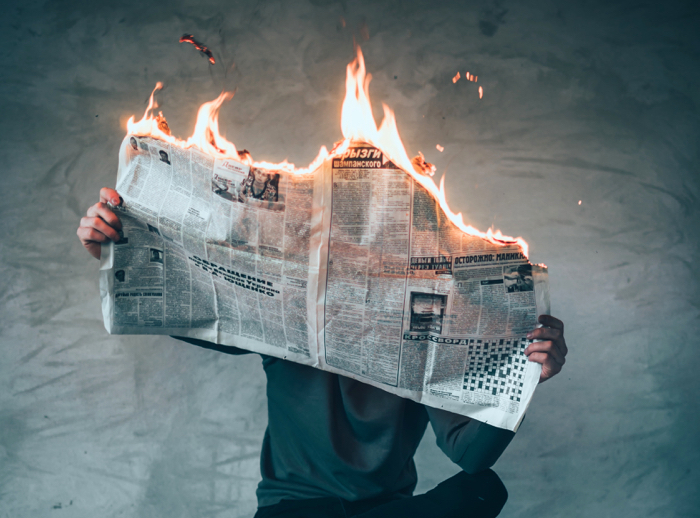
The term “fake news” encompasses two distinct concepts: fabricated stories masquerading as truth and the dismissal of legitimate news as false, often used to discredit unfavourable reporting.
Understanding these definitions is crucial for journalists committed to ethical practice.
The evolution of “fake news”
While fabricated information has existed throughout history, the contemporary concept of objective journalism, based on verifiable facts and unbiased reporting, is relatively recent.
The deliberate weaponisation of “fake news” to undermine credible sources gained prominence in recent years.
Dissecting fake news: types and motivations
There are many types of fake news. Here’s a breakdown:
- Errors: Unintentional inaccuracies due to mistakes or misunderstandings. These are generally forgivable.
- Satire: Intentionally humorous fabrications. While often harmless, satire can be misinterpreted or offensive.
- Misinformation (half-truths): The manipulation of real facts, often through selective quoting, to support a specific agenda.
- Disinformation (manufactured news): Deliberate fabrication designed to deceive, erode trust in reliable sources, and disrupt public discourse.
The social media factor
Social media platforms have become a breeding ground for “fake news,” fuelled by their accessibility, speed, and lack of content regulation.
The viral nature of social media amplifies misinformation, and the allure of sensational but false content often outpaces the spread of factual reporting.
Building trust chains: a journalist’s shield
The “trust chain” is a critical tool for combating “fake news.” It involves verifying information at every stage, from the original source to the final audience. The main principles include:
- Self-awareness: Acknowledge personal biases and strive for objectivity.
- Transparent reporting: Attribute sources and disclose any uncertainties.
- Critical evaluation: Question information, especially when it raises doubts.
- Source verification: Trace information back to its origin and assess its reliability.
- Fact vs. opinion: Clearly differentiate between verifiable facts and subjective opinions.
- Reliable sources: Cultivate relationships with trustworthy sources and utilise reputable news agencies.
- Cross-verification: Consult multiple independent sources to confirm information.
- Internet caution: Evaluate website credibility beyond surface appearances and avoid relying solely on online sources.
- Diverse perspectives: Compare reporting from various news outlets to identify potential biases or discrepancies.
Checklist to combat fake news
The proliferation of “fake news” threatens the foundation of informed public discourse.
- Journalists must prioritise rigorous fact-checking and transparency to maintain public trust.
- Media literacy is essential for audiences to discern credible information from misinformation.
- The speed of online information often overtakes the needed time for accuracy.
- Attributing sources within all reporting greatly increases accountability and builds trust.
By adhering to these principles, journalists can strengthen the “trust chain” and play a vital role in safeguarding the integrity of information.
This module is based on material published by The News Manual and reproduced with permission.

Questions
- What is the contemporary concept of objective journalism based on?
- Identify two types of fake news.
- How does satire differ from disinformation?
- Explain the role of social media in the spread of fake news.
- What is the “trust chain” and why is it important for journalists?
- List three principles of the “trust chain” that help combat fake news.
- How does misinformation differ from disinformation?
- Why is media literacy important for audiences in the context of fake news?
- Discuss the impact of the speed of online information on accuracy.
- How can journalists maintain public trust according to the text?
Answers
- The contemporary concept of objective journalism is based on verifiable facts and unbiased reporting.
- Two types of fake news mentioned are errors and satire.
- Satire is intentionally humorous and often harmless, while disinformation is deliberate fabrication designed to deceive.
- Social media amplifies misinformation due to its accessibility, speed, and lack of content regulation, often spreading sensational but false content faster than factual reporting.
- The “trust chain” is a process of verifying information at every stage to combat fake news, ensuring credibility from the original source to the final audience.
- Three principles of the “trust chain” include self-awareness, transparent reporting, and source verification.
- Misinformation involves manipulating real facts to support a specific agenda, while disinformation is the deliberate fabrication of false information.
- Media literacy is important because it enables audiences to discern credible information from misinformation, maintaining informed public discourse.
- The speed of online information often overtakes the time needed for accuracy, leading to the spread of unverified or false information.
- Journalists can maintain public trust by prioritising rigorous fact-checking, transparency, and attributing sources within all reporting.

The spectrum of information disorder
- Misinformation: False information that is shared, but without harmful intent.
- Disinformation: False information that is deliberately created and spread to cause harm.
- Malinformation: Information that is based on reality, used to inflict harm, such as private information spread publicly.
Types of fake news
- Fabricated content: Completely made-up stories designed to deceive. Often uses sensational headlines and emotional appeals.
- Manipulated content: Genuine content that has been altered, such as photoshopped images or edited videos. “Deepfakes” fall into this category, using AI to create realistic but false videos.
- Imposter content: Using the name or branding of a reputable source to spread false information. This can involve fake websites or social media accounts.
- False context: Genuine content that is presented with a false narrative or context.
For example, using an old photo to depict a current event. - Satire/Parody: While intended as humour, it can be mistaken for real news, especially if taken out of context.
- Clickbait: Sensational or misleading headlines designed to attract clicks, often with little relation to the actual content.
How to deal with fake news
- Verify the source:
- Check the website’s “About Us” section.
- Look for signs of professionalism and transparency.
- Investigate the author’s credentials.
- Cross-reference information:
- See if reputable news outlets are reporting the same story.
- Use fact-checking websites such as Snopes, PolitiFact, and FactCheck.org.
- Analyse the content:
- Be wary of emotionally charged headlines and sensational claims.
- Look for evidence and supporting sources. Pay attention to the date and time of publication.
- Check images and videos:
- Use reverse image search tools such as Google reverse image search to see if an image has been used elsewhere.
- Be aware of deepfakes and manipulated videos.
- Be alert to bias:
- Recognise your own biases and how they might influence your perception of information.
- Seek out diverse perspectives.
- Practice media literacy:
- Educate yourself and your audience about how to identify fake news.
- Promote critical thinking and healthy skepticism.
- When reporting:
- If you must report on fake news, do so in a way that clearly labels it as such.
- Provide accurate information to counter the false narrative.
- Avoid amplifying the fake news by repeating it unnecessarily.
- Use fact checking tools:
- There are many tools that can help fact check content.
- By staying informed and practicing these techniques, journalists can play a vital role in combating the spread of fake news and protecting the integrity of information.
Lesson plan for trainers
If you are a trainer of journalists we have a free lesson plan: ‘Fake news and trust chains‘ which you are welcome to download and adapt for your own purposes.









